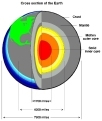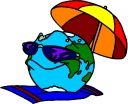
Worksheets and No Prep Teaching Resources
Reading Comprehension Worksheets
Earth
Earth's Land

Earth
 Worksheets and No Prep Teaching Resources Reading Comprehension Worksheets Earth Earth's Land |
 Earth |
| edHelper's suggested reading level: | grades 7 to 8 | |
| Flesch-Kincaid grade level: | 6.34 |
|
Glaciers
By Sharon Fabian |

|
 1 When it snows and schools close, we make the most of our time by sledding, building snowmen, and having snowball fights because snow usually doesn't last for long. At least in many places, snow falls and then it soon melts away. But in other places snow falls and stays. And stays. And stays. When it snows in places that are cold enough, the snow packs down into larger and heavier ice crystals, and the air is pushed out. Eventually it turns into glacial ice. Ordinary ice usually looks white, and that is mainly from all of the tiny air bubbles in ice. Very dense glacial ice becomes a beautiful blue.
1 When it snows and schools close, we make the most of our time by sledding, building snowmen, and having snowball fights because snow usually doesn't last for long. At least in many places, snow falls and then it soon melts away. But in other places snow falls and stays. And stays. And stays. When it snows in places that are cold enough, the snow packs down into larger and heavier ice crystals, and the air is pushed out. Eventually it turns into glacial ice. Ordinary ice usually looks white, and that is mainly from all of the tiny air bubbles in ice. Very dense glacial ice becomes a beautiful blue. |
Create Weekly Reading Books
Prepare for an entire week at once! |
| Leave your feedback on Glaciers (use this link if you found an error in the story) |
 |
Earth
|
 |
Earth's Land
|
 |
Science
|